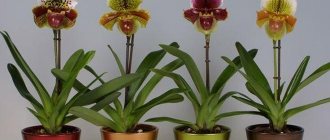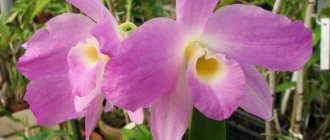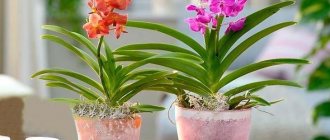Paphiopedilum , also Paphiopedilum , or Lady's slipper (Paphiopedilum) - belongs to the Orchid family (Orchidáceae) . These plants come from Nepal, India, China, Thailand, Malaysia, the Philippines,
Kalimantan, Sumatra and New Guinea.
The name of the genus is formed on the basis of two words: from the name of the homeland of the goddess Aphrodite (in Roman mythology - Venus) of the city of Paphos in Cyprus and the word pedilon - shoe, sandal. Literally Paphiopedilum is translated as Paphos slipper or shoe from Paphos.
Many representatives of the genus and hybrids with their participation are popular in indoor and greenhouse floriculture, and are also widely represented in botanical gardens.
Paphiopedilum first came to Europe in 1816 thanks to the Danish botanist Nathaniel Wallich, who brought this orchid from northeastern India.
The orchid is attractive and almost every orchid connoisseur wants to have it in his collection. But it is worth noting that this orchid may be too much for novice gardeners, so they should pay maximum attention to it.
Paphiopedilum wolterianum. ©A_and_B_Larsen_orchids
origin of name
The name of the genus is formed on the basis of two words: from the name of the homeland of the goddess Venus from the city of Paphos in Cyprus and the word pedilon (shoe, sandal).
Literally Paphiopedilum translates as Paphos slipper or slipper of Paphos .
Ancient mythology tells that once while hunting, the goddess Venus and Adonis were suddenly caught in a thunderstorm. The loving couple took refuge in a cave, and Venus left her wet shoes at the entrance.
A random traveler passing by did not notice the goddess and her lover, but saw golden shoes on the ground. As soon as he bent down to pick them up, the latter turned into beautiful flowers.
Description history
At the end of the 19th century, the genus received independent status; before that, they all belonged to the genus Cypripedium.
The first representative of this genus to reach Europe was Paphiopedilum venustum , found in 1816 in northeastern India by the Danish botanist Nathaniel Wallich and described from a specimen that bloomed in 1819 in the Calcutta Botanical Garden.
Paphiopedilum venustum
A little later, in the same region, Wallich found another similar plant, Paphiopedilum insigne , which was sent to England and bloomed in the Liverpool Botanic Garden in the autumn of 1820 .
Paphiopedilum insigne
In 1836 Paphiopedilum purpuratum bloomed at the Loddigzo Royal Exotic Nursery in England (this species is found near Hong Kong, in the Chinese province of Guangdong and on Hainan Island).
Paphiopedilum purpuratum
At the beginning of the 21st century, about 70 species have been described. One of the recently discovered species of this genus, Paphiopedilum hiepii, was discovered in the jungles of Vietnam in the late 1990s and described by St. Petersburg scientist L.V. Averyanov.
Paphiopedilum flowering
Care during flowering
If you properly care for the paphiopedilum orchid and provide it with optimal conditions for growth, then it will bloom every year, and even at the same time. It is from the young rosette formed during the current season that the appearance of a peduncle is observed. The fact that the bush is ready to flower can be understood by the following sign: a leaf plate will form at the growth point, which, after it grows to a certain size, will stop developing. However, the formation of a signal leaf plate does not mean that the orchid will definitely begin to bloom. But if you provide it with proper care, then the shortened plate will become denser over time and form a bud. Once this happens, do not move the plant and it is better not to touch it at all. The fact is that if a bush is ready to flower, this means that it is quite happy with the microclimate in which it is located, and moving it to another place can only ruin everything. Remember that each rosette can bloom only once.
Care after flowering
Immediately after flowering ends, the plant is given a good rest so that it can regain its strength at the beginning of the growing season. To do this, the bush is moved to a cooler place (from 15 to 20 degrees), watering should become less frequent, and no fertilizers are added to the substrate at all. Despite the fact that the paphiopedilum will be dormant, it will form a bud near the old outlet. It is from this that a young rosette and peduncle will grow in the coming season.
As soon as a young sprout appears, the bush should be provided with the temperature regime that is typical for it during the growing season. They also gradually return to the usual watering regime, and they also begin to feed the bush.
Biological description
Escape of sympodial type.
The stem is short.
All species have a rhizome Usually very shortened, but there are exceptions (Paphiopedilum druryi, Paphiopedilum robinsonii and Paphiopedilum armeniacum).
The roots are well developed.
The leaves are broadly linear, belt-shaped or oblong, close together in a double-sided rosette, from 5 to 60 cm. In some species the leaves are single-colored, pure green, while in others they have a dark marble pattern.
Peduncles from 4 to 60 cm long. Most species have single-flowered inflorescences. Paphiopedilum victoria-regina can produce more than 30 flowers successively on one peduncle. Multiflowered species produce several flowers on a single peduncle. From 2-3, to 13 or more.
Paphiopedilum victoria-regina
The flowers are large and varied in color. The upper sepal (sail), often wide and brightly colored, is sometimes folded forward like a visor, which limits rainwater from entering the inner part of the lip and onto the reproductive parts of the flower.
Paphiopedilums bloom for 2–9 months . The aroma is weak and inconsistent, with notes of vanilla and apple.
Based on the type of flowering, they are divided into three groups:
- single-flowered - one bud on the peduncle;
- multiflora - the plant has several buds that open at the same time;
- revolving - a multi-flowered orchid, during the flowering of one bud it forms the next.
All members of the tribe Cypripedioideae have two fruiting anthers, while other tribes have only one. The third anther is sterile, modified into a thyroid body called the "staminode", which is located in front of the column at the base of the lip and covers the reproductive parts.
Paphiopedilum often confused with Cypripedium . Unlike , Paphiopedilum:
- short stem;
- in rosettes from 4 to 12 leaves 10–35 cm long;
- the shape can be belt-like or broad-linear;
- color in different shades of green, plain and with a marble pattern;
- leaves are arranged symmetrically;
- peduncles from 4 to 50 cm high, often single-flowered, but there are also several buds (2–13 or more).
Types and varieties
We offer you an introduction to the most commonly grown indoor paphiopedilums.
Apricot Paphiopedilum (Paphiopedilum armeniacum)
Comes from the mountainous regions of China. It has green leaves up to 15 cm long with a marbled pattern of a darker shade, and on the back of the leaf blade there is a dark red dotted pattern. The pubescent green peduncle of the orchid is covered with purple specks. Paphiopedilum apricot blooms from the beginning of winter to the beginning of spring with bright yellow flowers up to 11 cm in diameter with a rounded lip and petals wavy along the edge.
In the photo: Apricot Paphiopedilum (Paphiopedilum armeniacum)
Appleton's Paphiopedilum appletonianum
It is a shade-loving plant native to China, Thailand, Cambodia, Vietnam and Laos, where it grows on moss-covered rocks or stumps. It has bright green, long, narrow and dense leaves, which are sometimes decorated with marble stains. In spring, the orchid opens flowers up to 10 cm in diameter with elongated lilac-violet petals decorated with green specks.
In the photo: Appleton's Paphiopedilum appletonianum
Paphiopedilum barbatum
This is a very popular plant species, from which the first hybrid, Harrisianum, was bred in 1869. The leaves of this orchid are up to 20 cm long, green with a marble pattern. Flowering occurs in the spring: the upper petal of the flower with a white upper edge and a pale green center is all lined with purple stripes, like a ruler. The side petals are approximately the same color, but not so bright, and the lip of the flower is large, red-purple.
- Photo of home gardenia
In the photo: Paphiopedilum barbatum
Paphiopedilum villosum
Originally from India and Indonesia. This is a tall orchid with a peduncle up to 30 cm in length. The plant blooms from autumn to spring with large flowers with a greenish-brown upper petal with a white border. The remaining petals are ocher with a brownish tint, and the pale red or brownish lip is mottled with thin veins.
In the photo: Paphiopedilum villosum
Paphiopedilum insigne
Distributed in the Himalayas. Its leaves are thin, up to 30 cm long. Flowering begins in September and lasts until February. This species has many varieties with flowers of different colors, but the color of the side petals of the most interesting of them is dominated by a coffee tint, and the upper petal of the hybrid has a yellow center with brown specks and a wide white stripe along the edge.
In the photo: Paphiopedilum insigne
Paphiopedilum lawrenceanum
From the island of Borneo, it is unpretentious in care and less demanding than other species in terms of living conditions. The orchid's leaves are up to 15 cm long, light green with streaks, and the flowers are large. The upper pointed petal has a striped green center, and closer to the edge the color gradually turns into a reddish tint. The lip is glossy, dark red, and the edges of the lateral petals are strewn with brown spots.
In the photo: Paphiopedilum lawrenceanum
Paphiopedilum hirsutissimum
Distributed in Laos, Thailand, Vietnam and India. Its leaves are narrow, the base of the peduncle is covered with a protective sheath. At the end of winter, fully pubescent large flowers appear from the buds, the upper petal of which at the beginning of flowering has a smooth edge, but with the beginning of withering the edge becomes wavy. The center of the petal is brown and the edges are light green. The side petals, smooth at the ends, of a rich purple color, gather closer to the middle into a ruffle.
In the photo: Paphiopedilum hirsutissimum
Paphiopedilum venustum
Grows in the wooded mountains of Nepal and India. The leaves of this orchid are elongated-elliptical, up to 5 cm wide, gray-green with dark green marbled streaks. The peduncle reaches a length of 20 centimeters or more. The plant has 8 varieties, and each of them has flowers differently colored, but the most interesting plant has side petals in the middle that are yellow or green, and closer to the wavy edges the color becomes burgundy with dark dots along the edge. The pale green upper petal, reminiscent of a triangle, is lined with clear stripes. The pale burgundy lip is mottled with random stripes, and its inner side is colored yellowish.
In the photo: lovely Paphiopedilum (Paphiopedilum venustum)
Paphiopedilum delenatii
A small orchid from Vietnam with elongated lanceolate leaves reaching a length of 10 and a width of 4 cm. The upper side of the leaf plate is decorated with a marble pattern of light and dark green spots, and a purple tint appears on the lower side. On peduncles up to 25 cm long, 1-2 flowers open up to 8 cm in diameter with white petals and a lip covered with merging light purple specks.
In the photo: Paphiopedilum delenatii
Paphiopedilum micranthum
It is found naturally in northern Vietnam and southern China at altitudes from 300 to 1600 m above sea level. The name given to the orchid does not suit it at all: the fragrant flowers of this species reach a diameter of 7 to 10 cm, and the white-pink lip of the flower is larger than that of any other representative of the genus. The plant has small, compact leaves with a velvety texture and a marbled pattern.
In the photo: Paphiopedilum micranthum
Snow Paphiopedilum (Paphiopedilum niveum)
Found in Kalimantan, the Malay Peninsula and Burma. Its stem is almost hidden by green, spotted leaves with lilac-purple undersides. This orchid blooms in summer. Two white flowers up to 7 cm in diameter, covered with pink specks on all petals, can form on the flower arrow.
In the photo: Paphiopedilum niveum
Pretty Paphiopedilum (Paphiopedilum bellatulum)
Either Paphiopedilum superimum or Paphiopedilum bellatulum grows on mossy rocks and slopes in China, Thailand and Burma. Its dark green leaves with lighter specks are divided in the middle by an even darker longitudinal stripe. In April, two white flowers up to 10 cm in diameter with dark crimson spots randomly scattered across the petals are formed on the peduncle.
In the photo: Pretty Paphiopedilum (Paphiopedilum bellatulum)
In addition to the described species, other representatives of the genus are also popular in culture: Paphiopedilum Rothschild, Paphiopedilum Godefroy, as well as orchids of hybrid origin Paphiopedilum American, in particular its variety Paphiopedilum Vinicolor Maudi.
Peculiarities
Only two species are epiphytes :
- Paphiopedilum parishii;
- Paphiopedilum lowii.
Paphiopedilum lowii
Three species of hemi-epiphytes (found growing on the ground and on trees):
- Paphiopedilum hirsutissimum;
- Paphiopedilum villosum;
- Paphiopedilum glanduliferum.
Paphiopedilum hirsutissimum
The remaining species are either terrestrial or lithophytes .
Conditions of detention
Temperature
Warm temperature orchids This includes virtually all spotted-leaved .
Summer : 20-25 °C; Winter : 16-22 °C.
2. Orchids of moderate temperature conditions. This includes Paphiopedilums with narrow green leaves .
Summer : during the day 20-22°C, at night 17-19°C; Winter : 20-23 °C during the day, 13-16 °C at night.
3. Orchids of moderate-warm temperature conditions. This includes almost all multicolored Paphiopedilums, i.e. “revolving” flowering orchids , when one flower fades and another appears on the same peduncle.
Summer : 20-23 °C; Winter : 18-22 °C.
4. Orchids of moderate temperature conditions. This includes Paphiopedilums with broad green leaves .
Summer : 18-25 °C; Winter : 16-20 °C.
It is advisable to ensure a difference between night and day temperatures of +3...+5 °C.
Lighting and location selection
Daylight hours are at least 12 hours .
Most species require bright, indirect light . This is a must for a multiflora group with monochromatic leaves .
Shade-tolerant and even shade-loving plants are orchids with marbled leaves .
Rest period
To stimulate flowering, Paphiopedilum with spotted leaves requires a clearly defined period of rest.
It starts in mid-November. The orchid is kept drier and colder than usual.
Night temperature during this period should be no more than +15 °C . Watering the orchid should be replaced with light spraying of the substrate.
After the appearance of flower stalks, the dormant period ends. Watering is resumed in the usual volume, and the temperature rises.
Failure to observe the rest period leads to not blooming .
Bloom
Paphiopedilums bloom once or twice a season , each species consistently at the same time.
The signal for flowering is a stop leaf in the center of a new rosette. It may turn out to be empty, but most often it produces a peduncle.
The height of flowering of the species Paphiopedilum occurs in autumn and spring , hybrids can bloom at any time of the year.
The duration of flowering in the general group varies from species to species and can range from 2 months to 2 years .
Paphiopedilums with one flower on a peduncle bloom for 2-4 months .
Paphiopedilums of “revolving” flowering, the flowers of which appear one after another on the same peduncle, bloom for 6-7 months , this includes Paphiopedilum glaucophyllum and Paphiopedilum primulinum.
Paphiopedilum Pinocchio
Paphiopedilum Pinocchio can bloom for up to 15 months , and Paphiopedilum chamberlainianum for up to 2 years.
Paphiopedilum chamberlainianum
After flowering
Actions after Paphiopedilum flowering directly depend on which subspecies the orchid belongs to.
1. In representatives of Paphiopedilum, in which there is only one flower the peduncle is removed after flowering , if necessary, the orchid is replanted and kept dry for some time. This is necessary to acclimatize the plant and to prevent rotting of wounds on the roots resulting from transplantation.
2. Representatives of “ revolving ” flowering do not prune until the end of flowering (up to 24 flowers appearing one after another on one peduncle):
- Paphiopedilum primulinum;
- Paphiopedilum glaucophyllum;
- Paphiopedilum Pinocchio;
- Paphiopedilum moquettinum;
- Paphiopedilum chamberlainianum.
Being outdoors
From June to the end of August, it is recommended to keep Paphiopedilum with green leaves outdoors: on the balcony or in the garden.
Choose a place protected from rain, strong winds and direct sunlight.
Diseases and pests
Due to too high humidity and insufficiently high air temperatures, paphiopedilums can suffer from fungal diseases. The infection is destroyed by treating the flower with fungicidal preparations. But if you do not eliminate errors in care and do not create the conditions necessary for the plant, the problem may return.
Among the pests that pose a danger to orchids of this genus are scale insects, mealybugs and spider mites.
Scale insects and scale insects are easy to spot on the underside of plant leaves. Take an ear stick, dip it in alcohol or a strong soap solution and mechanically remove the scale insects and adult scale insects from the plant. Then wash the plant in the shower, but if the parasites do not disappear even after this, you will have to use insecticides.
It will not be possible to remove spider mites from a plant manually, since their presence can only be recognized by yellowish puncture spots and the finest cobwebs on the leaves: these arachnid pests are so small in size that it is almost impossible to see them with the naked eye.
The plant infected with mites is washed in the shower, allowed to dry, after which the orchid is treated with a solution of Actellik, Karbofos or Fitoverm. Due to the toxicity of the drugs, it is better to carry out treatment outdoors.
Home care
Transfer
Due to the high degree of sensitivity of the root system to substrate salinity, they require periodic replanting into fresh substrate.
On average , transplantation is carried out every 2 years .
Paphiopedilum should not be replanted according to a schedule, but taking into account :
- species-specific features of the orchid;
- quality of water used for irrigation (presence of impurities and their quantity);
- composition of the substrate and the degree of its decomposition, salinity;
- composition of fertilizers used and frequency of fertilizing, etc.
You should focus on your conditions of detention and the needs of a particular orchid.
replant at the end of winter - beginning of spring (this is the period of root activity) or immediately after the plant has finished flowering.
In cases of salinity or decomposition of the substrate, it is necessary to replant the plant without waiting for the planned replanting season.
A few days before transplantation (3-5), the plant is not watered so that the substrate is dry at the time of transplantation. It is easier to remove the plant from a dry substrate without damaging the root system.
Removing a plant from an old substrate is carried out by freeing its root system from the remnants of the substrate, carefully pulling it out of the planting container.
The transplant is carried out into a pot corresponding to the root system of the orchid, i.e. according to the size of the roots (the diameter of the container is equal to the previous one or 1-2 cm larger).
Planting is done by immersing the orchid in a pot and filling it with substrate so that the root system of the plant is closed, the base of the shoot is buried in the substrate (1-3 cm - depending on the size of the plant being transplanted), and the lower leaves are above the surface of the substrate.
Substrate : 4-5 parts bark + 2 parts chopped sphagnum moss + 1 part peat.
Place a layer of sphagnum moss on the surface of the substrate (this increases the humidity of the environment and promotes the formation and good growth of roots).
Watering
Throughout the year, Paphiopedilum needs frequent and abundant watering.
When watering, excess water flow freely from the pot, since stagnation of water both inside the pot and in its tray can very quickly lead to rotting of the roots and lower part of the orchid.
The substrate should dry well between waterings, but not dry out completely. Keeping Paphiopedilum completely dry for a long time (2 or more days) is not acceptable.
Reproduction methods
Paphiopedilum orchids growing indoors are usually propagated by division. The bush is divided together with replanting in the spring. Please note that each division cut from the parent bush must have at least 3 shoots.
Dividing an orchid bush step by step:
- moisten the substrate in the pot well, then remove the bush from it;
- carefully remove any remaining substrate from the root system;
- using a pre-sterilized sharp instrument, cut out dried roots or rotten areas, and be sure to capture some of the healthy tissue;
- the plant is divided into the required number of parts;
- they treat fracture sites, cuts, and also wounds using activated or powdered charcoal;
- The cuttings must be planted in separate pots, at the bottom of which a drainage layer must be made.
During the first 15 days, the planted bushes are kept warm (from 21 to 22 degrees), while all watering is prohibited. However, using a fine sprayer, it is necessary to regularly moisten the air around the bush. When the bushes take root, they are provided with the same care as adult plants.











